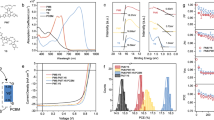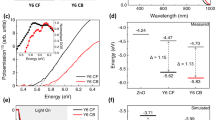Abstract
In an ideal model, a p–n junction is formed by two stacked slabs of semiconductors. Although the construction of actual devices is generally more complex, we show that such a simple method can in fact be applied to the formation of organic heterojunctions. Two films of the organic semiconductors poly(3-hexylthiophene) (P3HT) and [6,6]-phenyl-C61-butyric acid methyl ester (PCBM) can be connected by a simple film-transfer method without disturbing their flat surfaces. Each film can further be modified with a surface-segregated monolayer to tune the strength and direction of the surface dipole moment. Using this method, we fabricated bilayer organic photovoltaic devices with interfacial dipole moments that were selected to align the energy levels at the heterojunction. The open-circuit voltages of the P3HT/PCBM devices could be tuned over a wide range between 0.3 and 0.95 V, indicating that, even if the same combination of bulk materials is used, the interfacial properties drastically alter the performance of organic photovoltaic devices.
This is a preview of subscription content, access via your institution
Access options
Subscribe to this journal
Receive 12 print issues and online access
$259.00 per year
only $21.58 per issue
Buy this article
- Purchase on Springer Link
- Instant access to full article PDF
Prices may be subject to local taxes which are calculated during checkout




Similar content being viewed by others
References
Ishii, H., Sugiyama, K., Ito, E. & Seki, K. Energy level alignment and interfacial electronic structures at organic metal and organic organic interfaces. Adv. Mater. 11, 605–625 (1999).
Zhu, X. Y. & Kahn, A. Electronic structure and dynamics at organic donor/acceptor interfaces. MRS Bull. 35, 443–448 (2010).
Gregg, B. A. & Hanna, M. C. Comparing organic to inorganic photovoltaic cells: Theory, experiment, and simulation. J. Appl. Phys. 93, 3605–3614 (2003).
Scharber, M. C. et al. Design rules for donors in bulk-heterojunction solar cells—towards 10% energy-conversion efficiency. Adv. Mater. 18, 789–794 (2006).
Rand, B. P., Burk, D. P. & Forrest, S. R. Offset energies at organic semiconductor heterojunctions and their influence on the open-circuit voltage of thin-film solar cells. Phys. Rev. B 75, 115327–115337 (2007).
Gadisa, A., Svensson, M., Andersson, M. R. & Inganäs, O. Correlation between oxidation potential and open-circuit voltage of composite solar cells based on blends of polythiophenes/fullerene derivative. Appl. Phys. Lett. 84, 1609–1611 (2004).
Potscavage, W. J., Sharma, A. & Kippelen, B. Critical interfaces in organic solar cells and their influence on the open-circuit voltage. Acc. Chem. Res. 42, 1758–1767 (2009).
Yim, K. H. et al. Efficient conjugated-polymer optoelectronic devices fabricated by thin-film transfer-printing technique. Adv. Funct. Mater. 18, 1012–1019 (2008).
Chen, L. C., Degenaar, P. & Bradley, D. D. C. Polymer transfer printing: Application to layer coating, pattern definition, and diode dark current blocking. Adv. Mater. 20, 1679–1683 (2008).
Huang, J. H. et al. Fabrication of multilayer organic solar cells through a stamping technique. J. Mater. Chem. 19, 4077–4080 (2009).
Nakamura, M., Yang, C. H., Tajima, K. & Hashimoto, K. High-performance polymer photovoltaic devices with inverted structure prepared by thermal lamination. Sol. Energy Mater. Sol. Cells 93, 1681–1684 (2009).
Nakamura, M., Yang, C. H., Zhou, E. J., Tajima, K. & Hashimoto, K. Polymer bulk heterojunction photovoltaic devices with multilayer structures prepared by thermal lamination. ACS Appl. Mater. Interfaces 1, 2703–2706 (2009).
Wang, D. H. et al. Unexpected solid–solid intermixing in a bilayer of poly(3-hexylthiophene) and 6,6-phenyl C61-butyric acidmethyl ester via stamping transfer. Org. Electron. 11, 1376–1380 (2010).
Wang, D. H., Choi, D. G., Lee, K. J., Park, O. O. & Park, J. H. Photovoltaic devices with an active layer from a stamping transfer technique: Single layer versus double layer. Langmuir 26, 9584–9588 (2010).
Wei, Q. S., Tajima, K. & Hashimoto, K. Bilayer ambipolar organic thin-film transistors and inverters prepared by the contact-film-transfer method. ACS Appl. Mater. Interfaces 1, 1865–1868 (2009).
Wei, Q. S., Miyanishi, S., Tajima, K. & Hashimoto, K. Enhanced charge transport in polymer thin-film transistors prepared by contact film transfer method. ACS Appl. Mater. Interfaces 1, 2660–2666 (2009).
Wei, Q. S., Tajima, K. & Hashimoto, K. Electrical instability of polymer thin-film transistors using contact film transfer methods. Appl. Phys. Lett. 96, 243301–243303 (2010).
Hao, X. T. et al. Control of the interchain π–π interaction and electron density distribution at the surface of conjugated poly(3-hexylthiophene) thin films. J. Phys. Chem. B 111, 10365–10372 (2007).
Ayzner, A. L., Tassone, C. J., Tolbert, S. H. & Schwartz, B. J. Reappraising the need for bulk heterojunctions in polymer–fullerene photovoltaics: The role of carrier transport in all-solution-processed P3HT/PCBM bilayer solar cells. J. Phys. Chem. C 113, 20050–20060 (2009).
Wei, Q. S., Nishizawa, T., Tajima, K. & Hashimoto, K. Self-organized buffer layers in organic solar cells. Adv. Mater. 20, 2211–2216 (2008).
Yamakawa, S., Tajima, K. & Hashimoto, K. Buffer layer formation in organic photovoltaic cells by self-organization of poly(dimethylsiloxane)s. Org. Electron. 10, 511–514 (2009).
Wei, Q. S., Tajima, K., Tong, Y. J., Ye, S. & Hashimoto, K. Surface-segregated monolayers: A new type of ordered monolayer for surface modification of organic semiconductors. J. Am. Chem. Soc. 131, 17597–17604 (2009).
Li, G. et al. High-efficiency solution processable polymer photovoltaic cells by self-organization of polymer blends. Nature Mater. 4, 864–868 (2005).
Kim, S. S., Na, S. I., Jo, J., Tae, G. & Kim, D. Y. Efficient polymer solar cells fabricated by simple brush painting. Adv. Mater. 19, 4410–4415 (2007).
Ferenczi, T. A. M. et al. Planar heterojunction organic photovoltaic diodes via a novel stamp transfer process. J. Phys.: Condens. Matter 20, 8 (2008).
Collins, B. A. et al. Molecular miscibility of polymer–fullerene blends. J. Phys. Chem. Lett. 1, 3160–3166 (2010).
Yan, H. et al. Influence of annealing and interfacial roughness on the performance of bilayer donor/acceptor polymer photovoltaic devices. Adv. Funct. Mater. 20, 4329–4337 (2010).
Treat, N. D. et al. Interdiffusion of PCBM and P3HT reveals miscibility in a photovoltaically active blend. Adv. Energy Mater. 1, 82–89 (2011).
Chen, D. A., Nakahara, A., Wei, D. G., Nordlund, D. & Russell, T. P. P3HT/PCBM bulk heterojunction organic photovoltaics: Correlating efficiency and morphology. Nano Lett. 11, 561–567 (2011).
Lee, K. H. et al. Morphology of all-solution-processed ‘bilayer’ organic solar cells. Adv. Mater. 23, 766–770 (2011).
Perez, M. D., Borek, C., Forrest, S. R. & Thompson, M. E. Molecular and morphological influences on the open circuit voltages of organic photovoltaic devices. J. Am. Chem. Soc. 131, 9281–9286 (2009).
Duhm, S. et al. Orientation-dependent ionization energies and interface dipoles in ordered molecular assemblies. Nature Mater. 7, 326–332 (2008).
Acknowledgements
Y.F.G. thanks the Chinese Scholarship Council for financial support.
Author information
Authors and Affiliations
Contributions
A.T. and Y.F.G. contributed equally to this work. A.T. fabricated and evaluated the OPV devices and carried out the external quantum efficiency, XPS, UPS and X-ray reflectivity measurements. Y.F.G. synthesized and characterized the P3DDFT and carried out the XPS depth profile measurements. Q.S.W. synthesized and characterized the FC8. K.H. and K.T. directed the research. A.T., K.H. and K.T. wrote the paper.
Corresponding authors
Ethics declarations
Competing interests
The authors declare no competing financial interests.
Supplementary information
Supplementary Information
Supplementary Information (PDF 873 kb)
Rights and permissions
About this article
Cite this article
Tada, A., Geng, Y., Wei, Q. et al. Tailoring organic heterojunction interfaces in bilayer polymer photovoltaic devices. Nature Mater 10, 450–455 (2011). https://doi.org/10.1038/nmat3026
Received:
Accepted:
Published:
Issue Date:
DOI: https://doi.org/10.1038/nmat3026
This article is cited by
-
Recent progress in organic solar cells (Part II device engineering)
Science China Chemistry (2022)
-
Optimizing Photovoltaic Performance by Kinetic Quenching of Layered Heterojunctions
Chinese Journal of Polymer Science (2022)
-
Sub-picosecond charge-transfer at near-zero driving force in polymer:non-fullerene acceptor blends and bilayers
Nature Communications (2020)
-
FDTD simulation studies on improvement of light absorption in organic solar cells by dielectric nanoparticles
Optical and Quantum Electronics (2020)
-
Anatomy of the energetic driving force for charge generation in organic solar cells
Nature Communications (2019)



